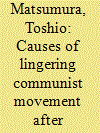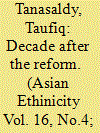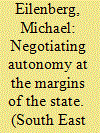|
|
|
Sort Order |
|
|
|
Items / Page
|
|
|
|
|
|
|
| Srl | Item |
| 1 |
ID:
157957


|
|
|
|
|
| Summary/Abstract |
This article focuses on the communist movement on both sides of the border in Sarawak and West Kalimantan around 1965 when the September Thirtieth Movement (abortive coup) took place in Jakarta. The people in Sarawak were seeking independence and opposed to being integrated into the Federation of Malaysia in the first half of the 1960s. However, after the September Thirtieth Movement, the communist movement in Sarawak started losing support both domestically and internationally (especially support from Indonesia). Nevertheless, even with the persecution by Suharto’s army, the Sarawak guerrillas and the Indonesian Communist Party in West Kalimantan cooperated in their struggle for a few years after 1965. This situation was aided by the remoteness of these areas from the centers of the nation-states (Malaysia and Indonesia) and also by the cooperation between the guerrillas and the local Chinese in West Kalimantan.
|
|
|
|
|
|
|
|
|
|
|
|
|
|
|
|
| 2 |
ID:
141158


|
|
|
|
|
| Summary/Abstract |
Political reform after the departure of President Soeharto’s New Order (1966–1998) provided opportunities for previously oppressed social groups to express their concerns and to demand fair recognition. The results of this newly found freedom have been quite immediately visible in Jakarta, where social and political institutions spearheaded by Chinese originally sprouted. In the regions, political participation of ethnic Chinese has also grown; significantly in those regions with a large Chinese population. In West Kalimantan, the number of Chinese being elected to local parliaments in some regions has doubled. They have also contested numerous direct local executive elections since 2003 and have been successful in winning four posts: a mayor, a district head, a deputy district head, and a deputy governor. By looking at the case of West Kalimantan, this article will examine the factors behind the growth in Chinese political activism, the factors contributing to the success of Chinese candidates in elections, how the Chinese have influenced local and provincial politics, and the challenges they are facing.
|
|
|
|
|
|
|
|
|
|
|
|
|
|
|
|
| 3 |
ID:
089884


|
|
|
|
|
| Publication |
2009.
|
| Summary/Abstract |
Recent processes of decentralization have dramatically changed local political configurations and access to resources throughout Indonesia. In particular, the resource-rich regions at the margins of the state have, in the name of regional autonomy, experienced new spaces for manoeuvre in their claims for a larger share of forest resources. By stressing the unfolding relationship between local ethnic elites and the state, and their different strategies in negotiating and claiming authority over forests within Indonesia's changing forest regimes, the paper examines how local-level politics has taken on its special configuration in the remote border region of West Kalimantan, Indonesia. The author demonstrates this by focusing on the ongoing struggle over forest resources and by tracking the fate of a political movement for a new district in this resource-rich region. The paper further examines how current local elite strategies and networks can be related back to the period of border militarization in the 1960s and, once again, how these seem to challenge the exclusivity of the Indonesian-Malaysian border. The main argument is that central authority in the borderland has never been absolute, but waxes and wanes, and thus that state rules and laws are always up for local interpretation and negotiation, although the degree of such negotiation changes depending on the strength of the central state.
|
|
|
|
|
|
|
|
|
|
|
|
|
|
|
|
| 4 |
ID:
080812


|
|
|
|
|
| Publication |
2008.
|
| Summary/Abstract |
This paper uses a political ecology perspective to examine relationships between violence and territory in West Kalimantan, focusing on the violent incidents of 1996-1997 and 1967-1968. Besides a regional account, the paper examines some of the ways residents of one village were drawn into and chose to participate in violence. The author concludes that while regional analyses can identify broad patterns, local analyses enable a greater understanding of both variation and the processes by which ethnic categories are constructed through violence.
|
|
|
|
|
|
|
|
|
|
|
|
|
|
|
|
| 5 |
ID:
089378


|
|
|
|
|
| Publication |
2009.
|
| Summary/Abstract |
The horrific violence that has marred Indonesia's 'transition to democracy' raises numerous disconcerting questions; not least of which is how future interested actors or governments - central and regional alike - will tackle these atrocities in a historical framework. How should a series of historical events, such as the killing of thousands of Indonesians by Indonesians be (un)officially remembered? Two paintings that hang in Sambas, West Kalimantan's most prominent cultural centrepiece, the Alwadzi Koebillah kraton, are remarkable, for they give us a glimpse as to how local voices might attempt to possess the historical meanings and readings of Indonesia's recent ethnic strife. Perhaps one of a kind in Indonesia, these paintings boldly portray the bloody battles that took place in Sambas in early 1999, pitting the 'courageous' and 'youthful' Malays of Sambas against the 'middle-aged' and 'treacherous' Madurese. These depictions make it abundantly clear that, through this bloodletting, Sambas Malays awoke from their slumber in time to mobilise, to confront and to defeat their nemesis. As an ethnopolitical force, the glorious rise of 'Malay' is unmistakable. The broader political context in which these paintings were commissioned, however, invests them with greater significance. Only in a decentralised state, one distinct from the excessive centralism of the New Order, would the (semi) public display of these heroic memorials to local, i.e. non-national, violence be made possible.
|
|
|
|
|
|
|
|
|
|
|
|
|
|
|
|
|
|
|
|
|